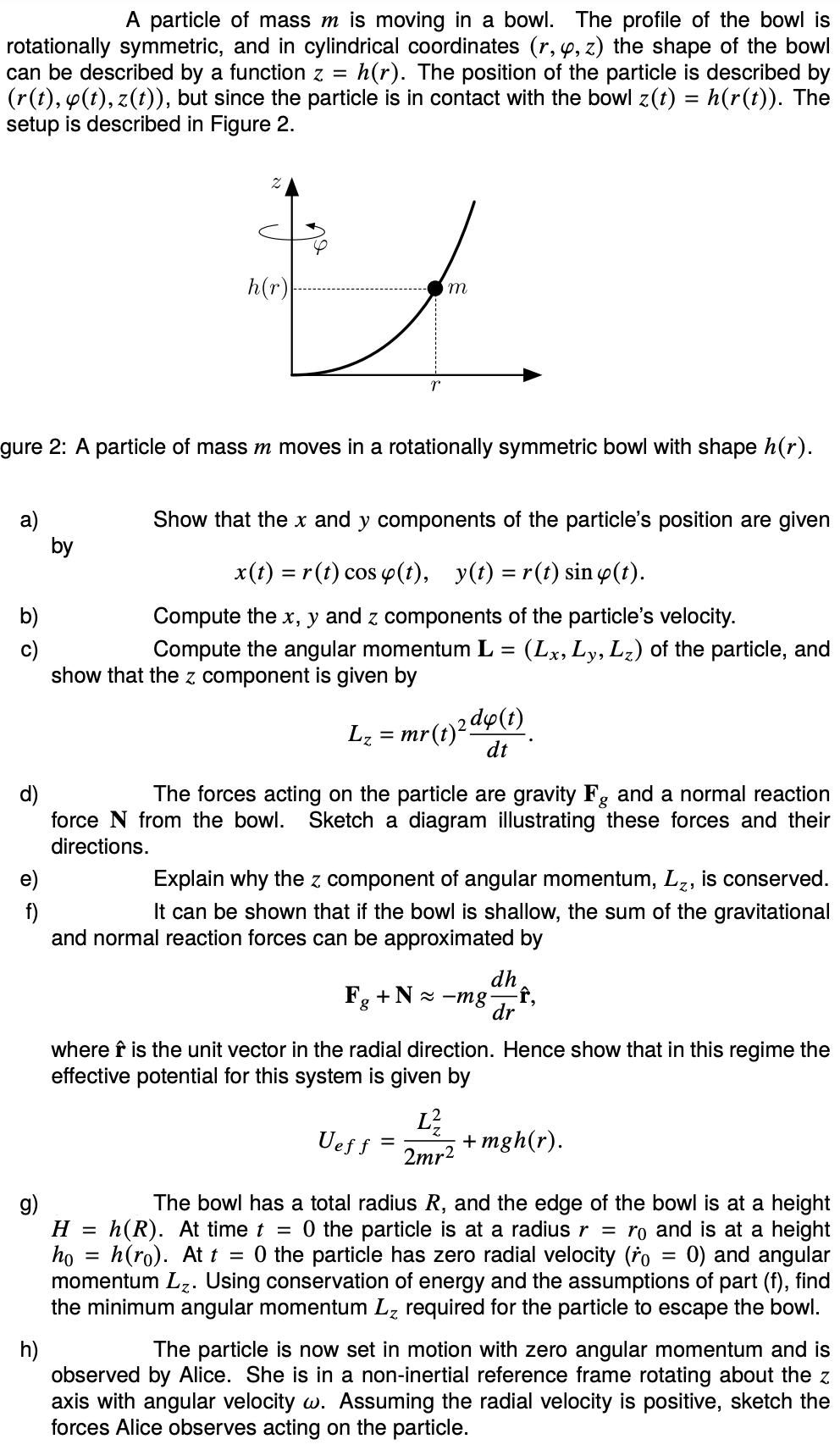A particle of mass m is moving in a bowl. The profile of the bowl is rotationally symmetric, and in cylindrical coordinates (r, y, z) the shape of the bowl can be described by a function z = (r(t), y(t), z(t)), but since the particle setup is described in Figure 2. h(r). The position of the particle is described by in contact with the bowl z(t) = h(r(t)). The h(r) gure 2: A particle of mass m moves in a rotationally symmetric bowl with shape h(r). Show that the x and y components of the particle's position are given a) by x(t) = r (t) cos 4(t), y(t) = r(t) sin o(t). b) Compute the x, y and z components of the particle's velocity. Compute the angular momentum L = (Lx, Ly, Lz) of the particle, and c) show that the z component is given by 2 dp(t) Lz = mr(t)²5 dt
A particle of mass m is moving in a bowl. The profile of the bowl is rotationally symmetric, and in cylindrical coordinates (r, y, z) the shape of the bowl can be described by a function z = (r(t), y(t), z(t)), but since the particle setup is described in Figure 2. h(r). The position of the particle is described by in contact with the bowl z(t) = h(r(t)). The h(r) gure 2: A particle of mass m moves in a rotationally symmetric bowl with shape h(r). Show that the x and y components of the particle's position are given a) by x(t) = r (t) cos 4(t), y(t) = r(t) sin o(t). b) Compute the x, y and z components of the particle's velocity. Compute the angular momentum L = (Lx, Ly, Lz) of the particle, and c) show that the z component is given by 2 dp(t) Lz = mr(t)²5 dt
Related questions
Question

Transcribed Image Text:A particle of mass m is moving in a bowl. The profile of the bowl is
rotationally symmetric, and in cylindrical coordinates (r, 4, z) the shape of the bowl
can be described by a function z =
(r(t), p(t), z(t)), but since the particle is in contact with the bowl z(t) = h(r(t)). The
setup is described in Figure 2.
h(r). The position of the particle is described by
h(r|
m
gure 2: A particle of mass m moves in a rotationally symmetric bowl with shape h(r).
Show that the x and y components of the particle's position are given
a)
by
x(t) = r(t) cos 4(t), y(t) = r(t) sin o(t).
Compute the x, y and z components of the particle's velocity.
Compute the angular momentum L = (Lx, Ly, L2) of the particle, and
b)
c)
show that the z component is given by
mr(t)²5
dt
2 dp(t)
L7 =
d)
force N from the bowl.
The forces acting on the particle are gravity Fg and a normal reaction
Sketch a diagram illustrating these forces and their
directions.
e)
Explain why the z component of angular momentum, Lz, is conserved.
It can be shown that if the bowl is shallow, the sum of the gravitational
f)
and normal reaction forces can be approximated by
dh
-f,
F, +N = -mg
dr
where f is the unit vector in the radial direction. Hence show that in this regime the
effective potential for this system is given by
L?
+ mgh(r).
2mr2
Uef f -
g)
H = h(R). At time t = 0 the particle is at a radius r = ro and is at a height
ho
The bowl has a total radius R, and the edge of the bowl is at a height
h(ro). At t = 0 the particle has zero radial velocity (ro = 0) and angular
momentum Lz. Using conservation of energy and the assumptions of part (f), find
the minimum angular momentum Lz required for the particle to escape the bowl.
%3D
h)
observed by Alice. She is in a non-inertial reference frame rotating about the z
axis with angular velocity w. Assuming the radial velocity is positive, sketch the
forces Alice observes acting on the particle.
The particle is now set in motion with zero angular momentum and is
Expert Solution
This question has been solved!
Explore an expertly crafted, step-by-step solution for a thorough understanding of key concepts.
This is a popular solution!
Trending now
This is a popular solution!
Step by step
Solved in 3 steps with 4 images
